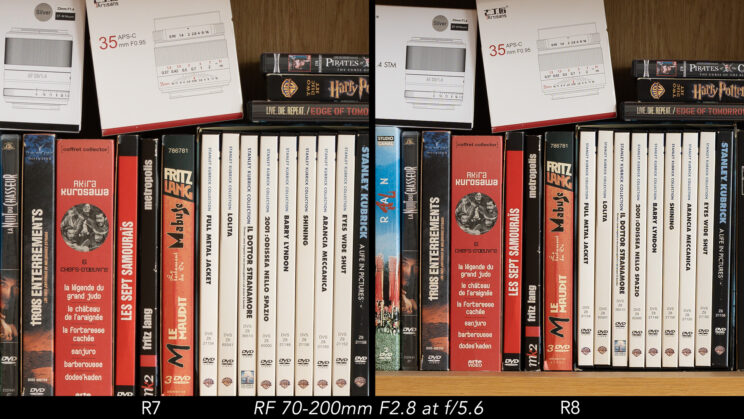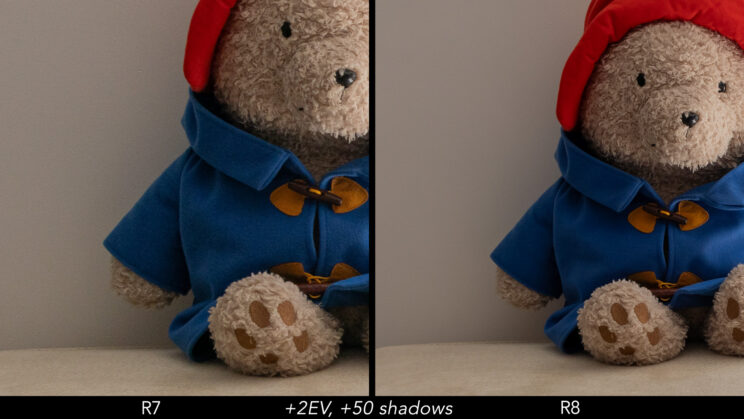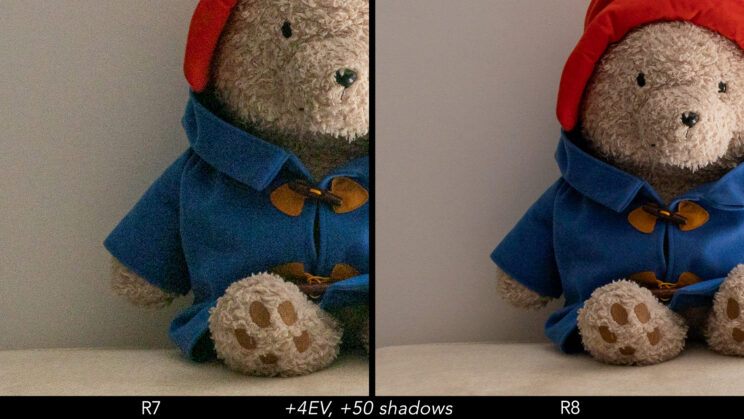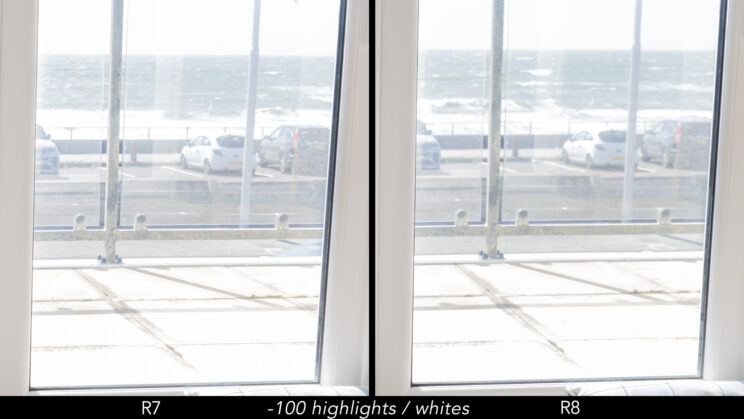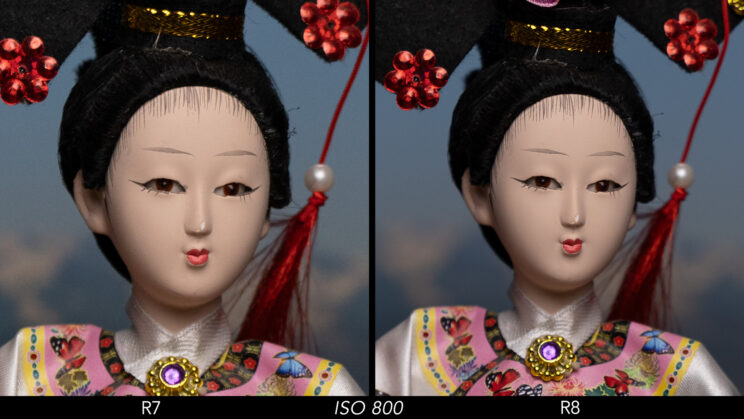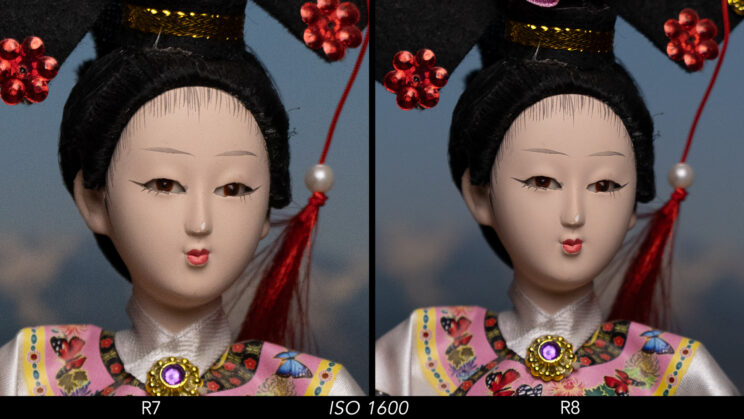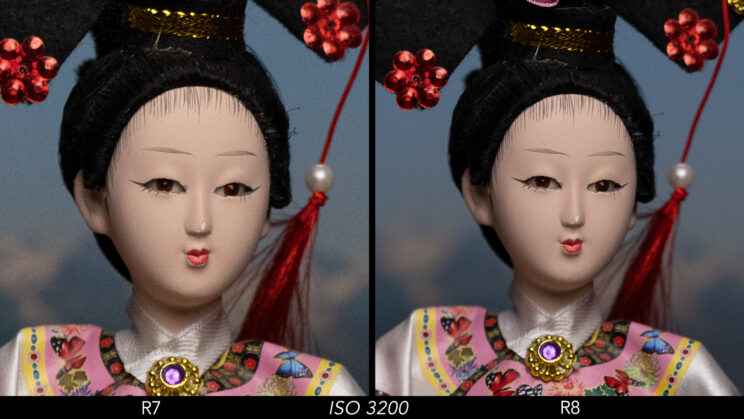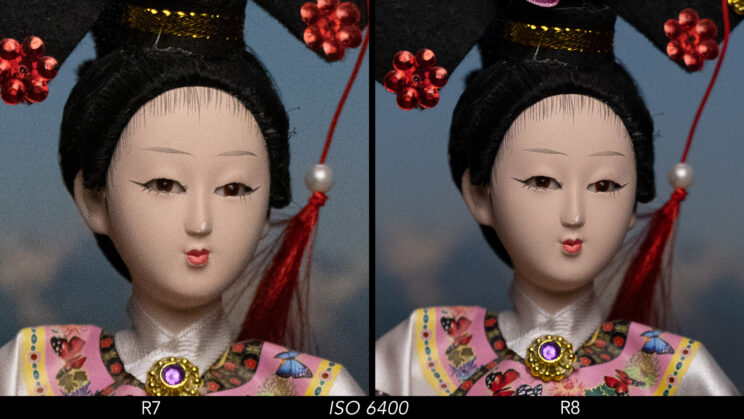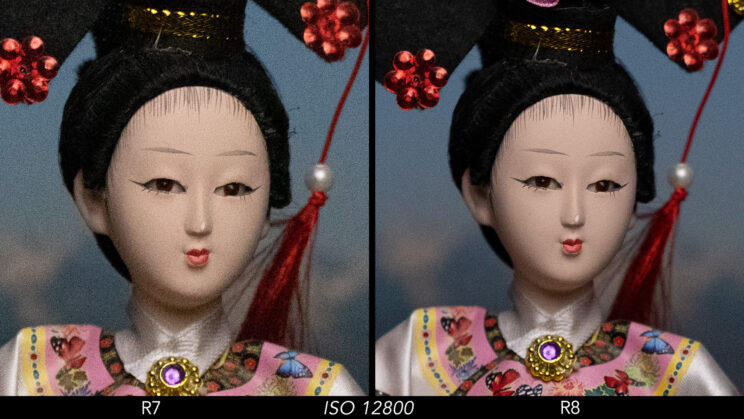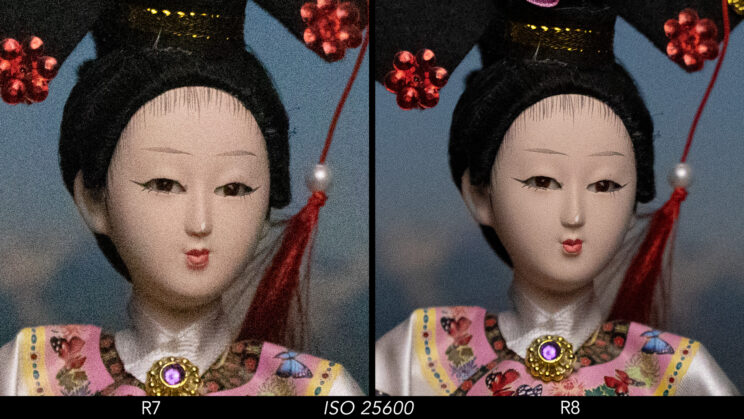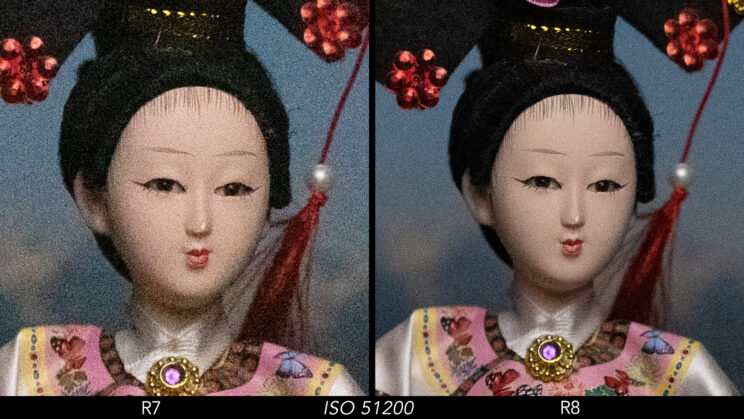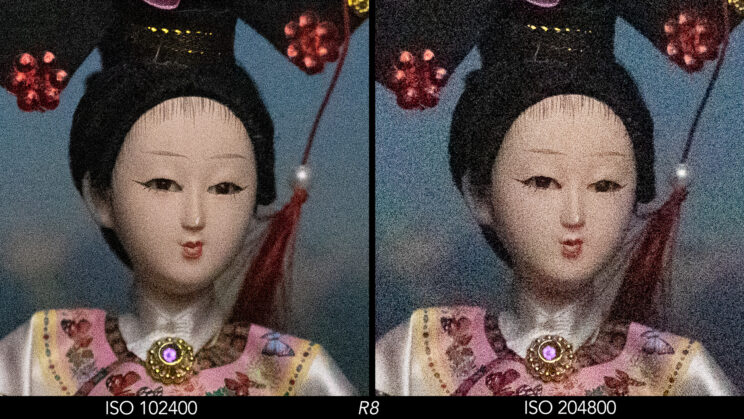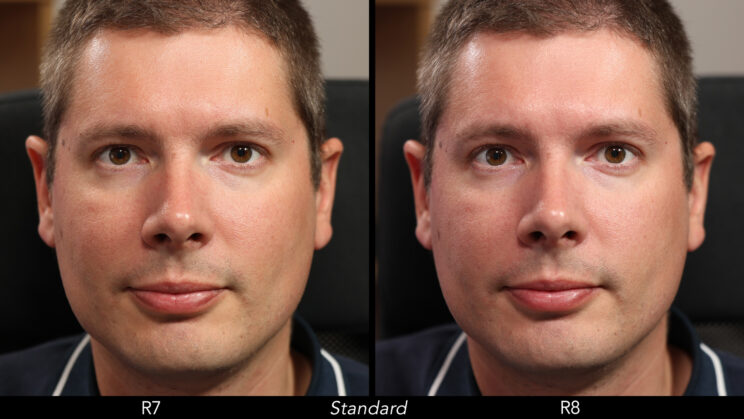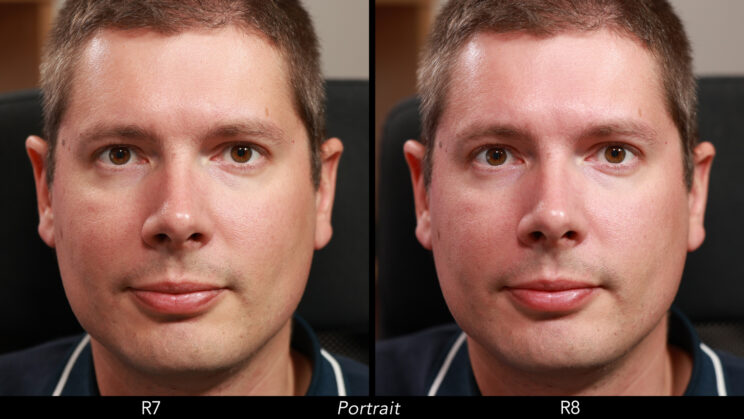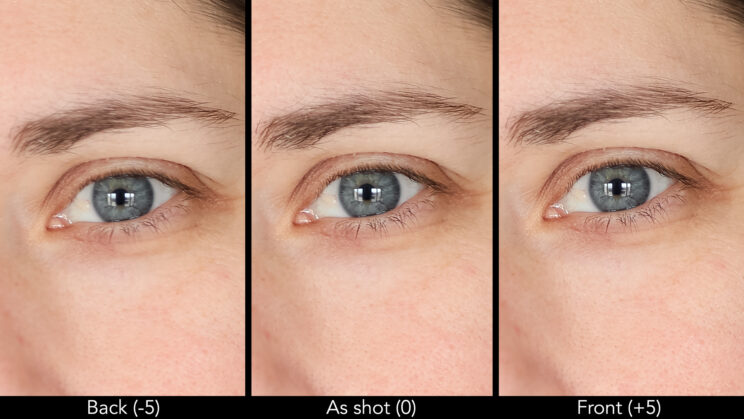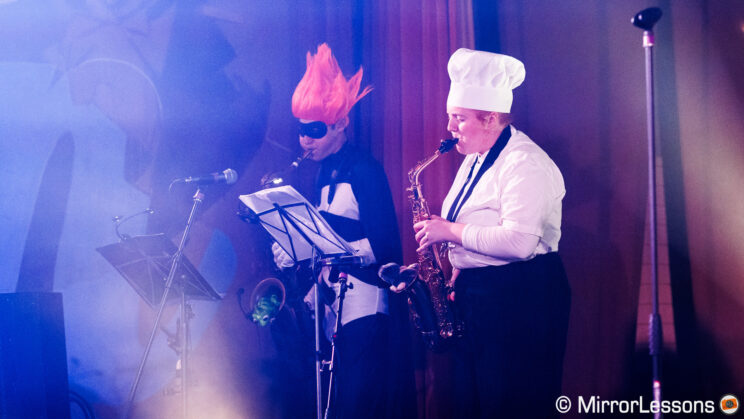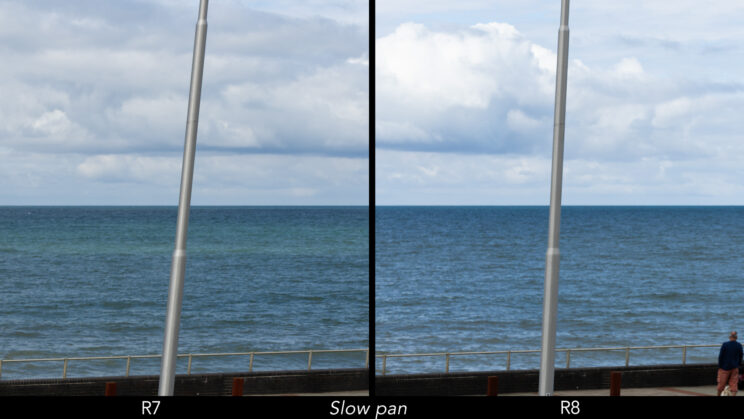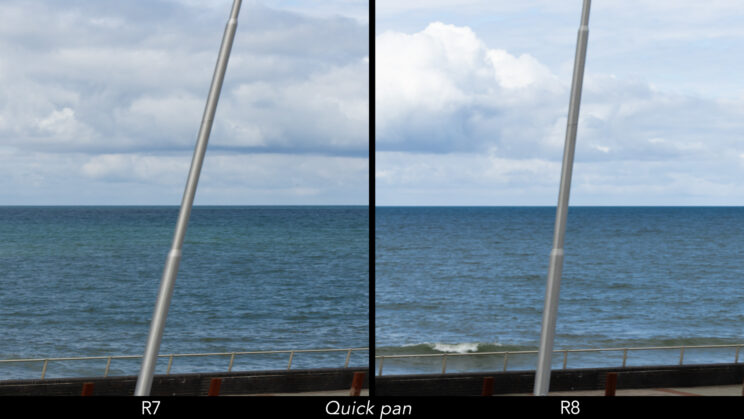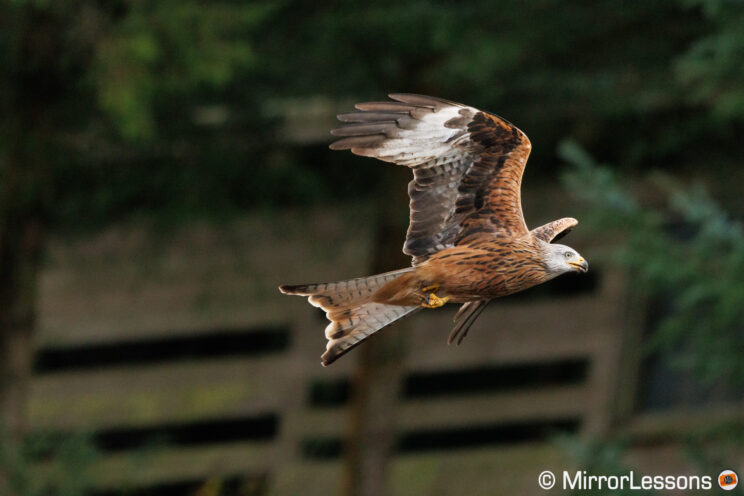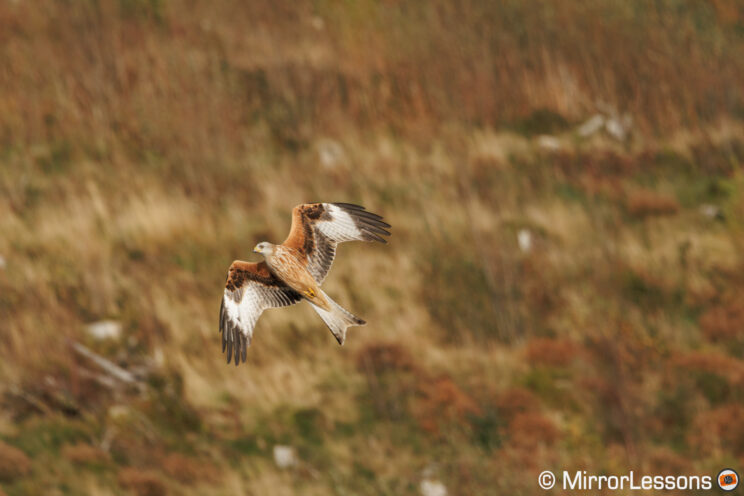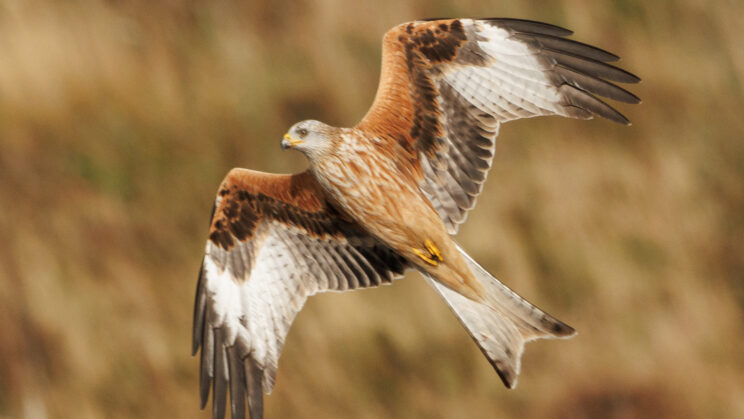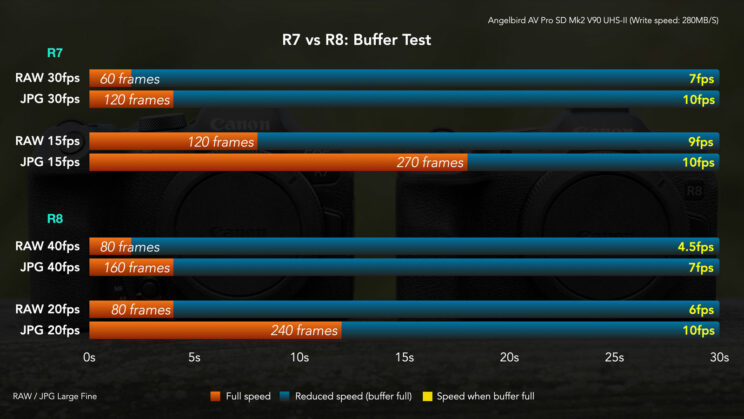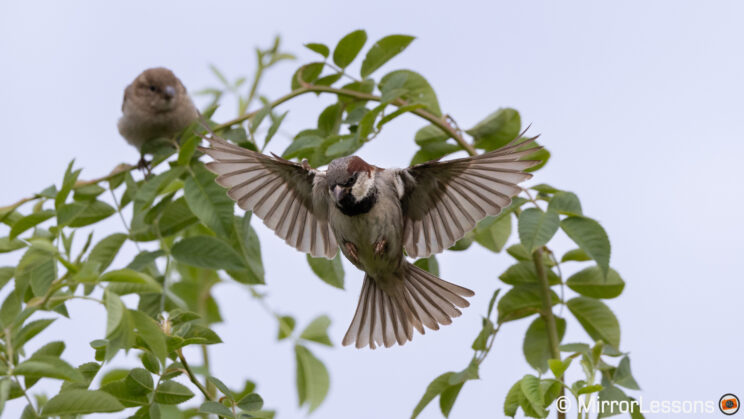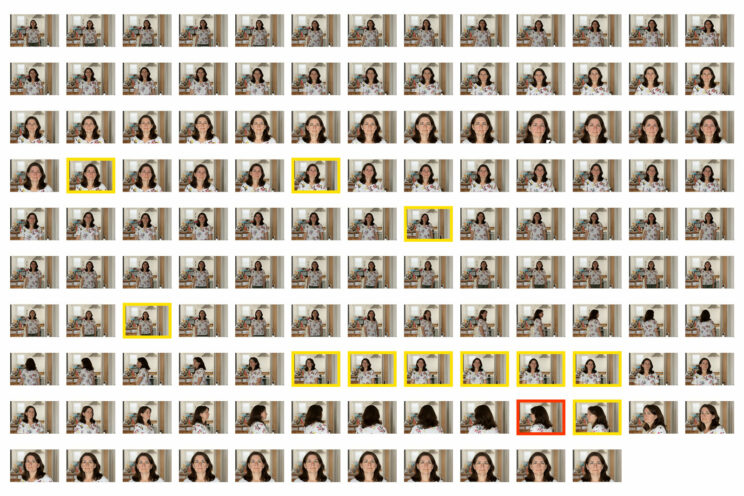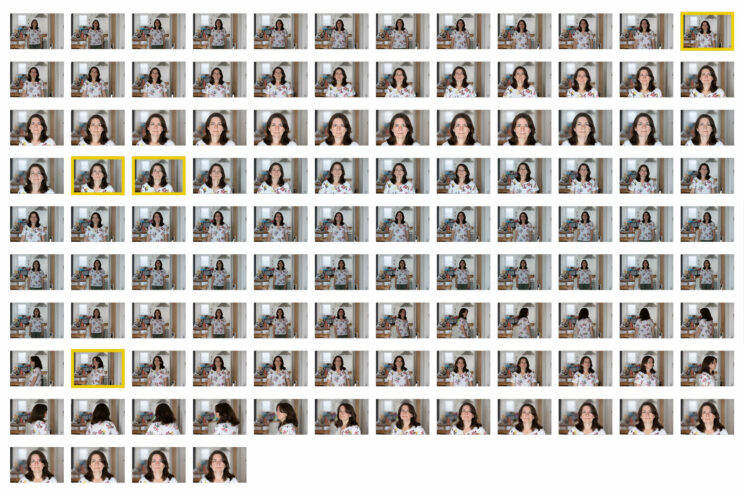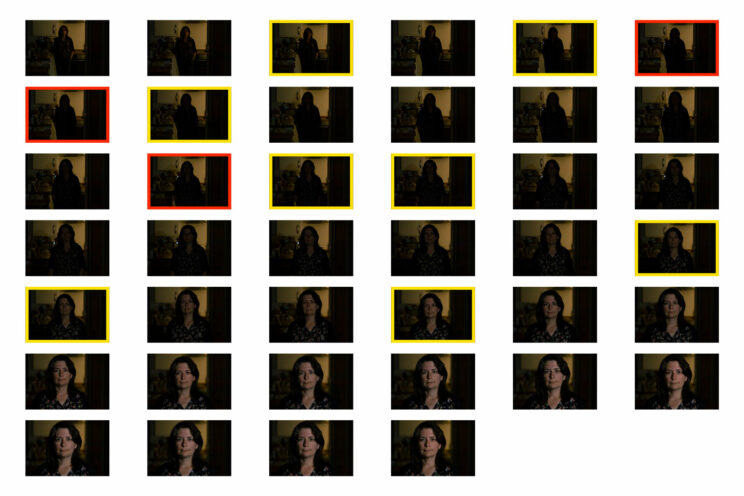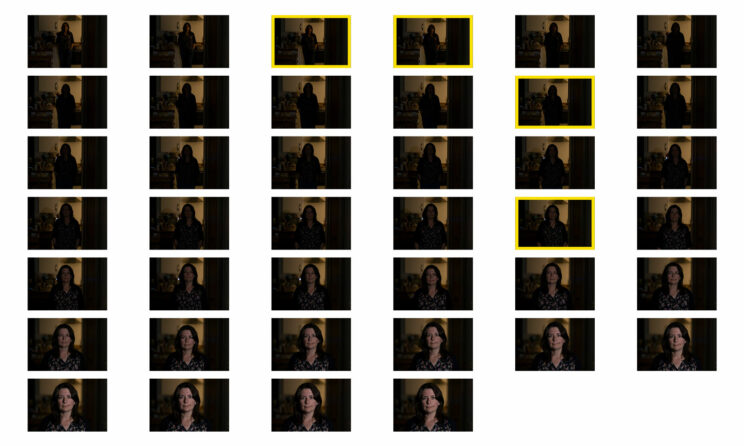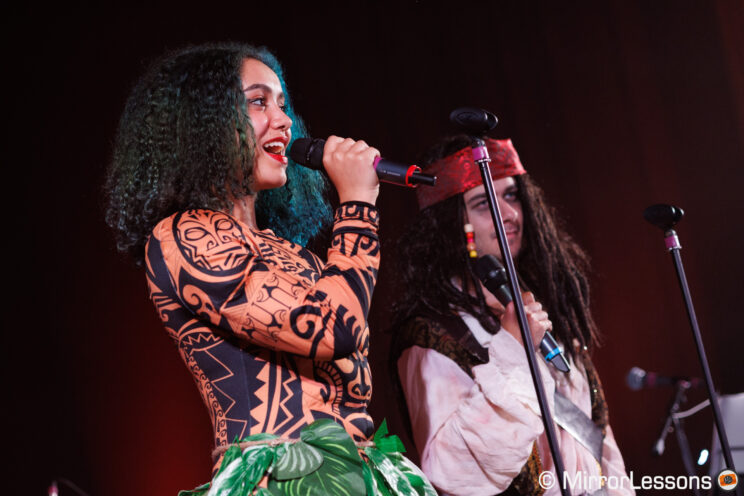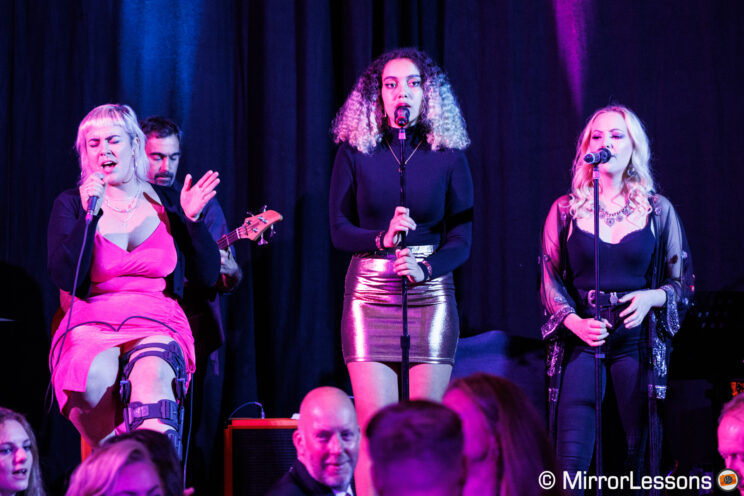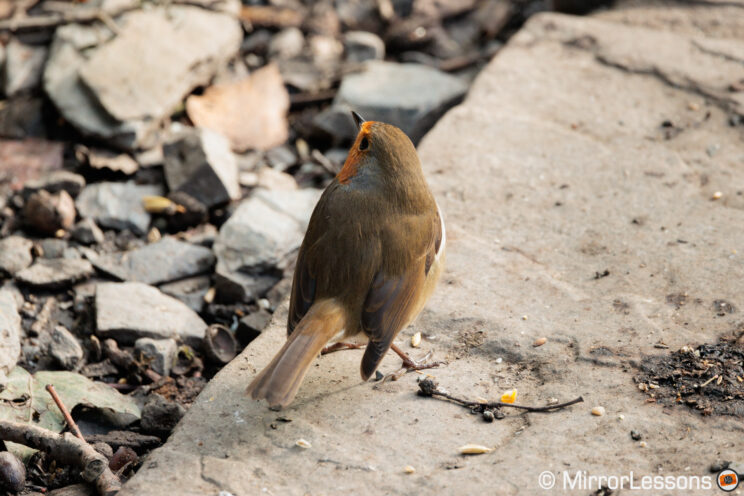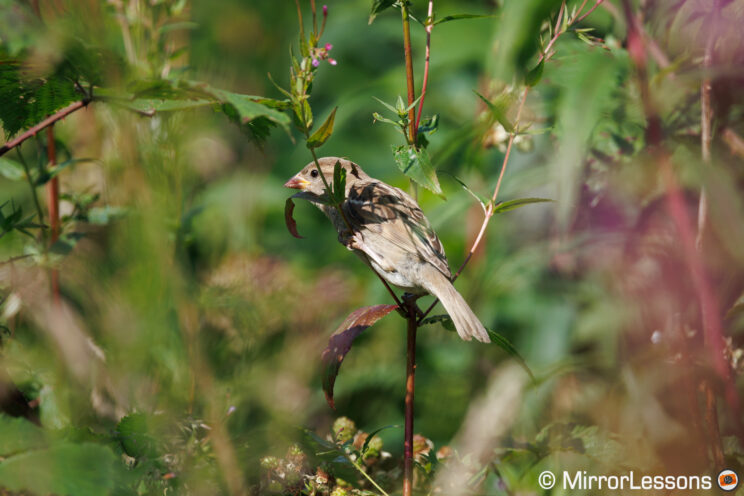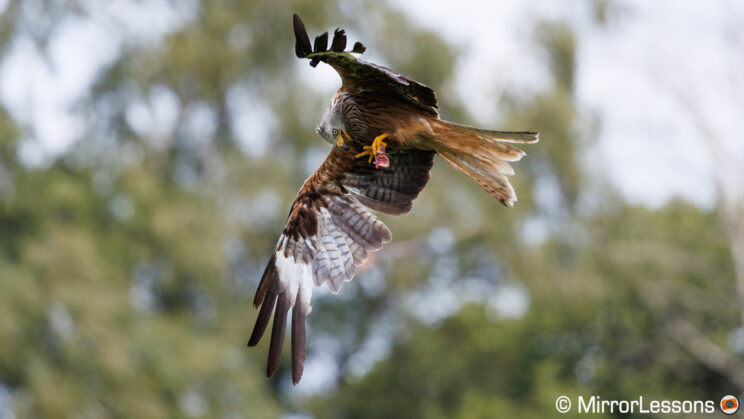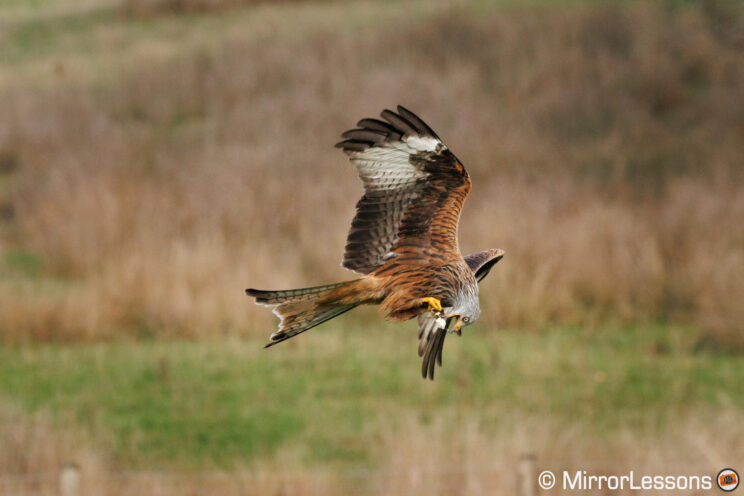The Canon R8 is an entry-level full frame camera. It takes a lot from the more expensive R6 mark II, but in a smaller package, designed for amateurs and enthusiasts. It has a competitive price that puts it close to the EOS R7, one of Canon’s most popular mirrorless models at the moment.
The two products differ in many ways. In this comparison article, I’ll guide you through the 10 most important things you need to know before deciding which to buy.
Note: this article has been upgraded to a full comparison with real world tests and sample images.
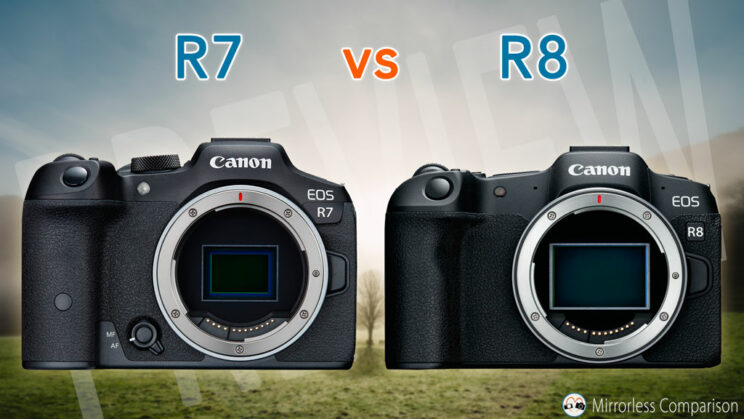
Ethics statement: this article is based on my personal experience with the R7 and R8. We were not asked to write anything about this product, nor were we provided any compensation of any kind. Within the article, there are affiliate links. If you buy something after clicking one of these links, we will receive a small commission. To know more about our ethics, you can visit our full disclosure page. Thank you!
Table Of Contents
– Main Specs
– The 10 Main Differences in a Nutshell
1. Sensor
2. Video
3. Stabilisation
4. Shutter Mode
5. Continuous Shooting Speed
6. Autofocus
7. Design
8. Battery Life
9. SD Cards
10. Price and Lenses
– Review Video
– Conclusion
Main Specs
R7
- Sensor: 32.5MP APS-C format CMOS
- Lens system: RF-mount
- Weatherproof: Yes
- Internal Stabilisation: Yes (5-axis)
- Autofocus: Dual Pixel CMOS AF II with 5,915 points
- Continuous shooting: 15fps, or 30fps with e-shutter
- ISO Sensitivity: 100 – 32000 ISO (push up to 51200)
- Shutter Speeds: 1/8000s to 30s, Bulb
- Viewfinder: 0.39-in OLED with 2,360k dots, 22mm eye point, 0.72x magnification
- Rear monitor: Multi-angle 3.0″ LCD (1.62M dots) with touch sensitivity
- Movie recording: 4K up to 60fps and 340Mbps, Full HD up to 120fps, 10-bit C-Log3 and HDR PQ
- Built-in Flash: No
- Extra Features: WiFi, Bluetooth, Bracketing, Focus Stacking, Tethering, Time-lapse, Dual SD slots
- Dimensions: 132.0 x 90.4 x 91.7mm
- Weight: 612g (including battery and memory card)
- Firmware version: 1.3.1
- Release: 2022
R8
- Sensor: 24.2MP 35mm format CMOS
- Lens system: RF-mount
- Weatherproof: Yes
- Internal Stabilisation: No
- Autofocus: Dual Pixel CMOS AF II, Subject Detection
- Continuous shooting: 6fps (mechanical), 40fps (electronic)
- ISO Sensitivity: 100 – 102400 ISO (pull 50, push up to 204800)
- Shutter Speeds: 1/8000s to 30s, Bulb, 1/16,000s with e-shutter
- Viewfinder: 0.39-in OLED with 2.36M dots, 22mm eye point, 0.70x magnification
- Rear monitor: Multi-angle 3.0″ LCD (1.62M dots) with touch sensitivity
- Movie recording: 4K up to 60p and 340Mbps, Full HD up to 180p, 10-bit C-Log3 and HDR PQ
- Built-in Flash: No
- Extra Features: WiFi, Bluetooth, Focus Stacking, RAW Burst Mode, Tethering, Time-lapse
- Dimensions: 132.5 × 86.1 × 70.0 mm
- Weight: 461g (including battery and memory card)
- Firmware version: 1.0
- Release: 2023
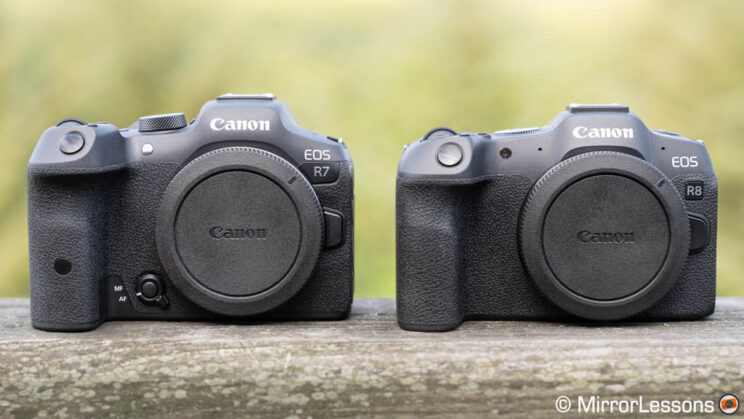
The 10 Main Differences in a Nutshell
- Sensor: The R7 offers higher resolution, but the larger sensor of the R8 delivers greater dynamic range and less noise at high ISO.
- Video: Sharpness and dynamic range are very similar, but the R8 provides better quality in 4K 50/60p due to oversampling, while the R7 employs line-skipping. The full-frame camera also exhibits less rolling shutter and noise at high ISO. On the other hand, the APS-C model excels in internal heat management.
- Stabilisation: The R8 lacks in-body stabilization, requiring reliance on lenses with optical stabilization. This gives the R7 and its IBIS mechanism an advantage in scenarios involving slow shutter speeds, or when walking during video sequences. Surprisingly, the R8 paired with an IS lens performs better when recording static shots.
- Shutter Mode: The R8 doesn’t feature a full mechanical shutter, utilizing only the EFCS (Electronic-First Curtain Shutter), which can introduce limitations under specific conditions and settings.
- Continuous Shooting Speed: With the electronic shutter, the R7 operates at up to 30fps, while the R8 achieves a faster 40fps. The full-frame camera exhibits less rolling shutter, a weak point in the R7. The buffer performance is more or less comparable.
- Autofocus: The R8 employs more advanced software, resulting in better detection of humans, animals, and vehicles. It also offers greater consistency in keeper rate and focus precision, especially in low-light conditions and when capturing birds in flight.
- Design: The R7 boasts a larger grip, an AF joystick, and additional buttons. The EVF and LCD screen remain the same.
- Battery Life: The R7 employs a larger battery and can last significantly longer, particularly in video mode.
- SD Cards: Only the R7 comes equipped with two card slots.
- Price and Lenses: The cost is relatively close in the U.S., but the R8 is pricier in Europe. Currently, there are only three native RF lenses designed for APS-C cameras. R7 users must rely on full-frame EOS R lenses or adapt Canon’s DSLR lenses. Support for third-party brands remains uncertain at the moment.
Reminder: the links below are affiliate links. If you decided to buy something after clicking the link, we will receive a small commission.
Check the price of the Canon EOS R7 on:
Amazon | Amazon UK | B&H Photo | eBay
Check prices of the Canon R8 on
Amazon | Amazon UK | B&H Photo | eBay
Second-hand Canon cameras on
MPB US | MPB UK
1. Sensor
Let’s begin with the heart of each model: the image sensor!
The R8 features a full frame sensor with 24.2MP, whereas the R7 incorporates a smaller APS-C sensor but with more resolution: 32.5MP. They both have a low pass filter and the same Digic X image processor.
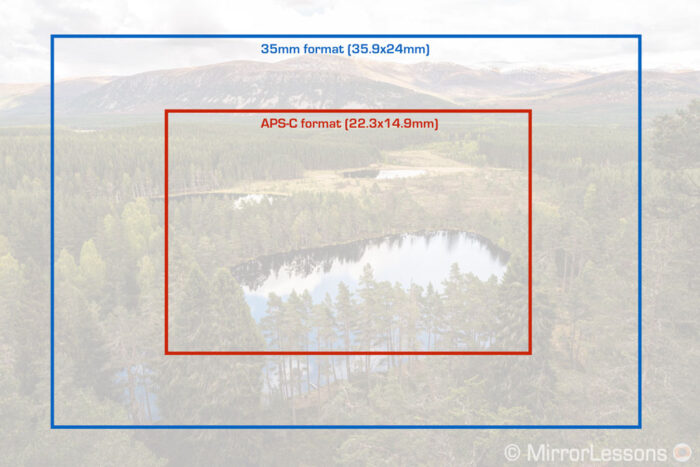
Our first test revolves around sharpness, using the same lens for both cameras. The R7 produces more defined and smoother details, although the difference may not be as substantial as initially anticipated, considering the megapixel gap. It’s possible that the R7’s low pass filter is stronger than the one fitted on the R8.

Next we have dynamic range, and we start with a balanced exposure, where both cameras retain a very good level of detail in the shadows and highlights. However, the RAW file of the R8 is more clean in the darker regions of the image, whereas the R7 shows a bit of noise already.
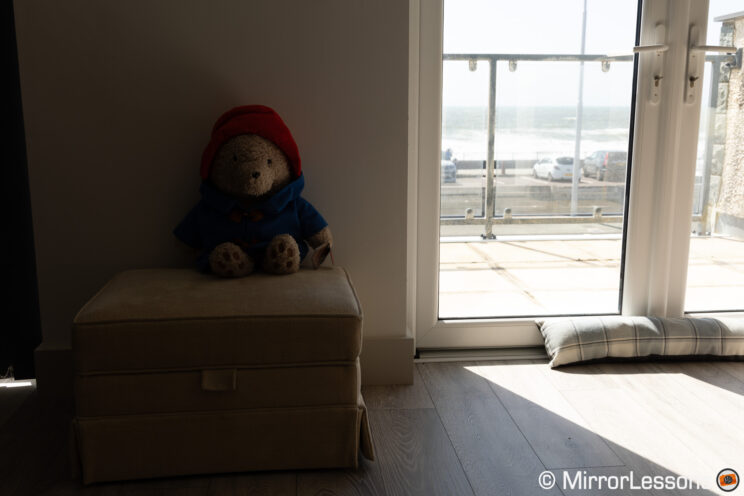
With a more extreme exposure recovery in the shadows, the limitations of the R7’s sensor become more apparent: the noise increases and a subtle colour cast emerges in contrast to the R8.
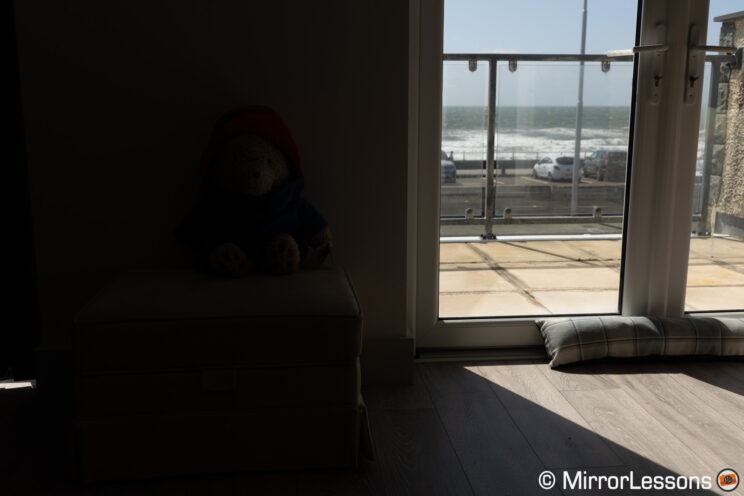
In terms of highlights recovery, both cameras demonstrate similar capabilities.
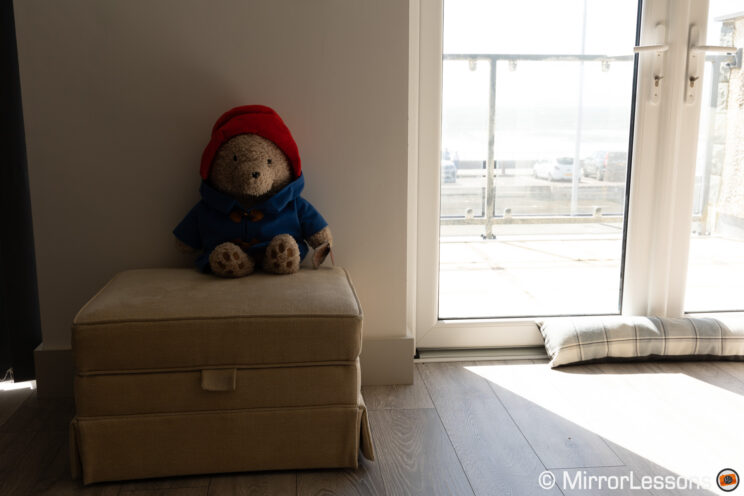
The ISO range is different, as you can see from the table below:
Photo mode
Normal range
Extended range
R8
100 – 102,400
50 – 204,800
R7
100 – 32,000
100 – 51,200
As expected, the R7 exhibits extra noise as you increase the ISO levels, with the distinction becoming more apparent from 3,200 ISO. The R7 remains usable at 12,800 ISO, while the R8 maintains acceptable quality up to 51,200 ISO.
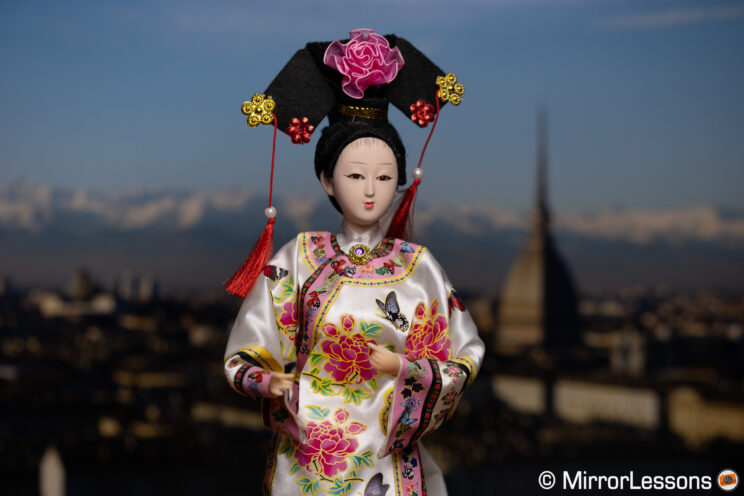
Moving on to straight-out-of-camera JPGs and skin tones, you can see that with the Standard style, the R7 has more yellow, whereas the R8 leans more towards reds.
Switching to the Portrait style, the R7 delivers a well-balanced result in my opinion, while the R8 shows subtle hints of magenta.
With the Neutral style, the R8 strikes a better balance this time, whereas the R7 tends to veer towards yellow.
Additionally, both cameras can record 10-bit HEIF photos, and they include the Dual Pixel RAW mode that allows you to make micro adjustments to the focus point and the bokeh in post, using the Canon Photo Professional software.
Reminder: the links below are affiliate links. If you decided to buy something after clicking the link, we will receive a small commission.
Check the price of the Canon EOS R7 on:
Amazon | Amazon UK | B&H Photo | eBay
Check prices of the Canon R8 on
Amazon | Amazon UK | B&H Photo | eBay
Second-hand Canon cameras on
MPB US | MPB UK
2. Video
Note: you can watch side by side tests in my YouTube Video Review available at the end of this article.
The two cameras can record in 4K up to 60p, but not with the same image processing.
The R8 oversamples from 6K (meaning it uses every available pixel) to deliver the best quality possible whatever frame rate you select.
The R7 applies the same method up to 30p, oversampling from a 7K area. If you want 50p or 60p however, it works with line-skipping, which decreases the quality of the footage.
In my 4K 25p test, both cameras deliverexcellent details. The R7 appears slightly sharper, although the difference is not very significant.
When moving to 4K 50p, the R8’s footage has better quality due to its continued use of oversampling. On the other hand, the R7, employing line-skipping, introduces more aliasing, leading to less smooth and refined details.
Another option is to use the 4K crop mode to record at 60p on the R7, but that translates into a severe 1.8x sensor crop, which alters the angle of view of your lens significantly.
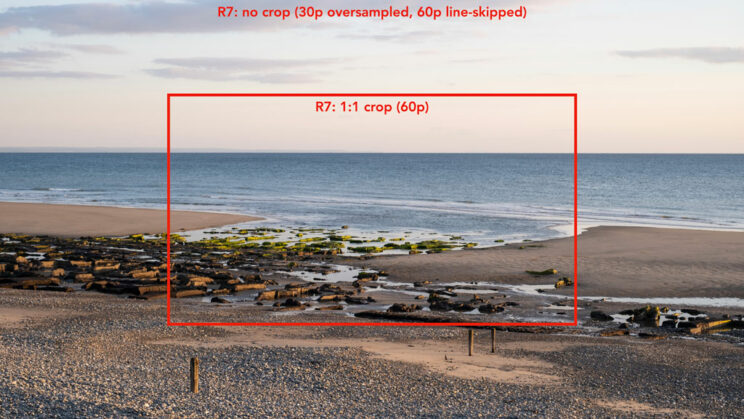
In Full HD, the High Frame Rate mode on the R8 allows recording up to 180p, while the R7 stops at 120p.
Both cameras share a range of advanced settings, including the capability to record internally in 10-bit 4:2:2 when selecting the Canon Log3 or HDR PQ profiles. The maximum bitrate stands at 340Mbps. They offer a clean 10-bit 4:2:2 output via the HDMI port, although there’s no RAW option available.
Surprisingly, the R7 performs really well in terms of dynamic range. With the C.Log3 profile, it holds its ground against the R8, preserving very similar levels of shadow and highlight details.
In video mode, the ISO range is different from the photo mode, as you can see below.
Video mode
Normal range
Extended range
R8
100 – 25,600
102,400
R7
100 – 12,800
25,600
Unsurprisingly, the R7 exhibits more noise, which becomes visible from 1,600 ISO and becomes more pronounced at 3,200 ISO. The R8 remains very good even at 12,800 ISO, or even 25,600 ISO for challenging situations, whereas the R7’s quality really deteriorates at those levels. The R8 can go all the way up to 102,400 ISO, but the amount of noise is too invasive by that point.
Rolling Shutter is less pronounced on the R8, similarly to its performance in photo mode. The distinction becomes more evident with fast movements. You can reduce distortion on both cameras by working at 50 or 60p.
Neither camera has a recording limitation in 4K up to 30p. The R7 kept going for 2 hours and 20 minutes in my test (21˚C room temperature). There is no limit in 4K 60p either, but the camera will stop earlier (around 60 minutes).
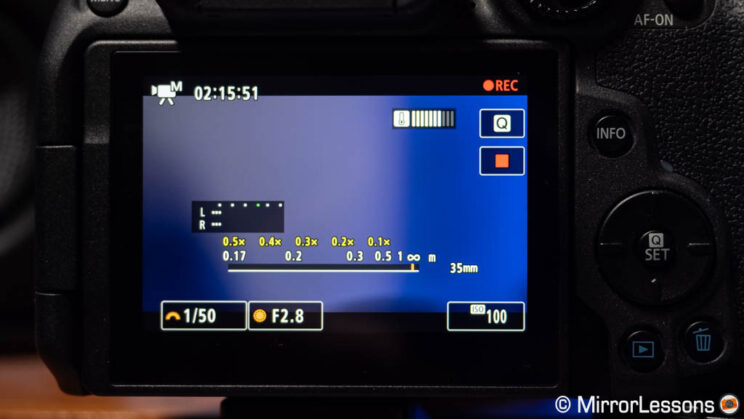
In comparison, the R8 has a limit of 2 hours per clip, but is capable of recording these full 120 minutes without any problem. In 4K 60p, the full frame model has a 30-minute limitation per clip and, in my test, it stopped after 23 minutes the first time, and 28 minutes the second time when I did my test again the following morning.
Also noteworthy is the clever overheat indicator on the screen of both cameras, comprising 10 bars that gradually appear to alert you about the rising internal temperature. This provides ample warning prior to any complete shutdown.
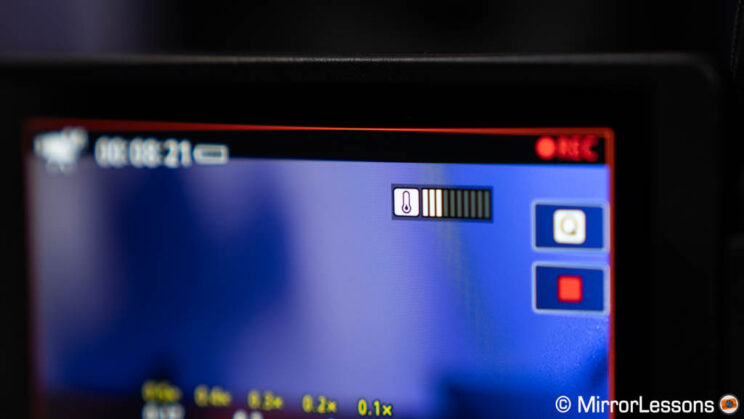
3. Stabilisation
One major difference between these two cameras is the absence of in-body image stabilisation on the R8. With the full frame camera, you have to rely on RF lenses with optical stabilisation. Thankfully, many Canon mirrorless lenses have IS, so you won’t be left with nothing to work with.
The R7 includes 5-axis sensor stabilisation with a rating of 7 stops of compensation (it’s actually 8, but only with the expensive RF 50mm F1.2 that you’ll likely won’t buy for your APS-C camera).
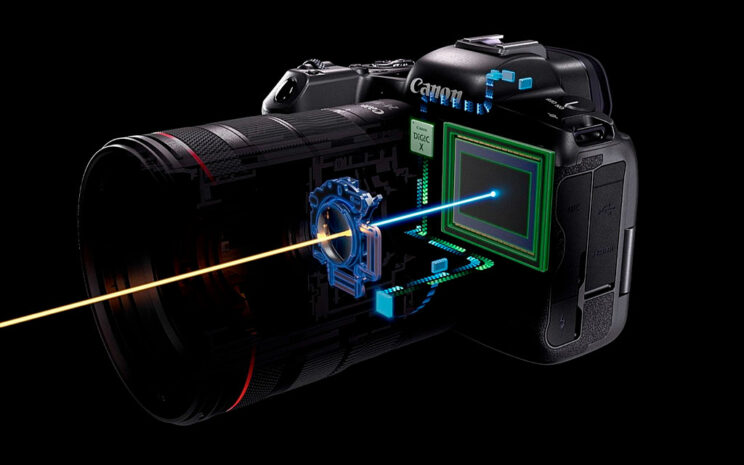
Without a doubt, the R7 delivers superior capabilities for hand-held photography when using slow shutter speeds. As you can see in the table below, I achieved a commendable keeper rate even with a two-second exposure.
However, the test unveiled a surprising result for the R8, or perhaps should I say for the RF 24-105mm F4 lens. Despite relying solely on optical stabilisation, I successfully captured sharp images at one second. Beyond this point, the gap between the R8 and the R7 narrows, and their performance remains comparable from 1/4s onwards.
Stabilisation Test (RF 24-105mm F4 at 24mm)
Shutter Speed
R7 (IBIS+OIS)
R8 (OIS)
2s
30%
0%
1s
40%
30%
1/2s
60%
50%
1/4s
80%
80%
1/8s
100%
100%
1/15s
100%
100%
Naturally, the outcome can vary based on the lens you pair with the R8, and you’ll always be reliant on a lens with optical stabilisation for the full frame camera, while the R7 itself can always provide stabilisation, regardless of the lens used.
In terms of video, the R7 delivers steadier footage when walking with the camera. The R8, on the other hand, struggles to minimise movements using optical stabilisation alone.
Interestingly, when capturing static shots with the RF 70-200mm F2.8 at 200mm, it’s actually the R8 that produces more stable footage. This remains consistent even when Digital IS is engaged, which involves electronic stabilization and sensor cropping. This suggests that optical stabilization alone proves to be more dependable with longer focal lengths.
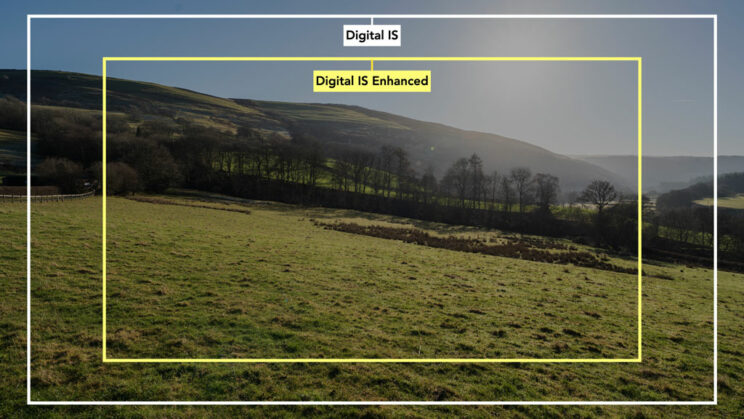
On the other hand, the R7 presented a similar issue to what I encountered with the R6 while using the same 70-200mm F2.8 lens. There are moments where it appears that optical stabilization and sensor stabilization are in conflict, resulting in unexpected jerks within the footage. After waiting for five to ten seconds, the stability improves.
Reminder: the links below are affiliate links. If you decided to buy something after clicking the link, we will receive a small commission.
Check the price of the Canon EOS R7 on:
Amazon | Amazon UK | B&H Photo | eBay
Check prices of the Canon R8 on
Amazon | Amazon UK | B&H Photo | eBay
Second-hand Canon cameras on
MPB US | MPB UK
4. Shutter Mode
There are a few things to digest here, so let’s begin with something basic.
The R8 can shoot up to 1/4000s with the mechanical shutter, or 1/16,000s with the electronic shutter. The R7 is faster with the mechanical shutter (1,8000s), but shares the same maximum speed with the e-shutter.
Now, the term “mechanical shutter” isn’t entirely accurate when referring to the R8. Let’s delve into this topic.
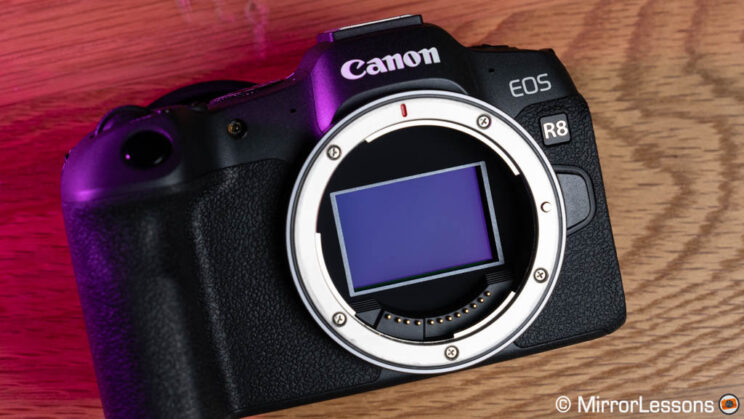
The full frame camera doesn’t have a full mechanical shutter, meaning it doesn’t have the front and rear curtains that cover and uncover the sensor when you take a picture (something that is found on most cameras). Only the rear (second) curtain is present. The front (first) curtain is activated electronically, hence the term Electronic-First Curtain Shutter, or EFCS: that’s what the R8 uses, in addition to the full electronic shutter mode, where both curtains are activated electronically.
The R7, on the other hand, has full mechanical, electronic-first and full electronic shutter modes.
The electronic-first curtain shutter mode of the R8 can cover most of the functions that the fully mechanical shutter of the R7 offers, including the use of flash. However, there are two limitations you should be aware of:
- The bokeh can become less pleasant with fast apertures (such as f/1.4 or f/2) and high shutter speeds (like 1/2000s or 1/4000s).
- There can be uneven exposure with similar settings, resulting in one part of the image appearing slightly darker than the other.
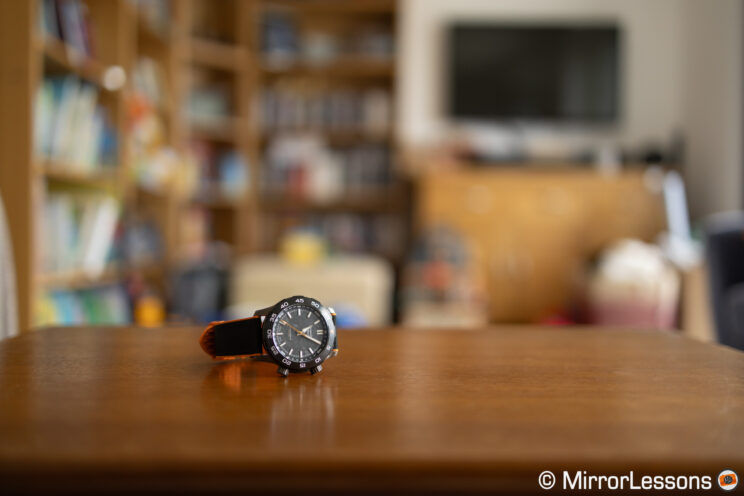
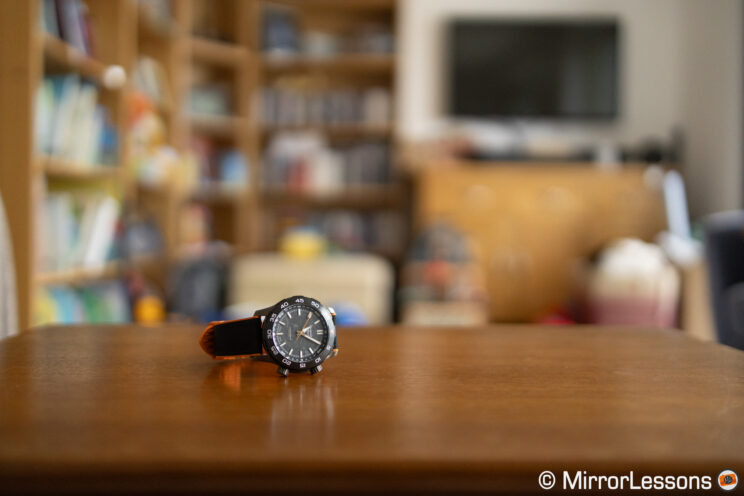
Furthermore, regardless of the aperture or shutter speed used, there’s a possibility of encountering some banding with artificial lighting. Although this banding is not as prominent as with the standard electronic shutter.
If you encounter issues with the electronic-first curtain shutter (EFCS), you have the option to switch to the electronic shutter on the R8. However, it’s important to note that using the electronic shutter can bring its own set of limitations. For example, you might experience banding in your images due to high-frequency LED lights, or distortion caused by rapid camera movements. Additionally, flash usage is disabled when using the electronic shutter.
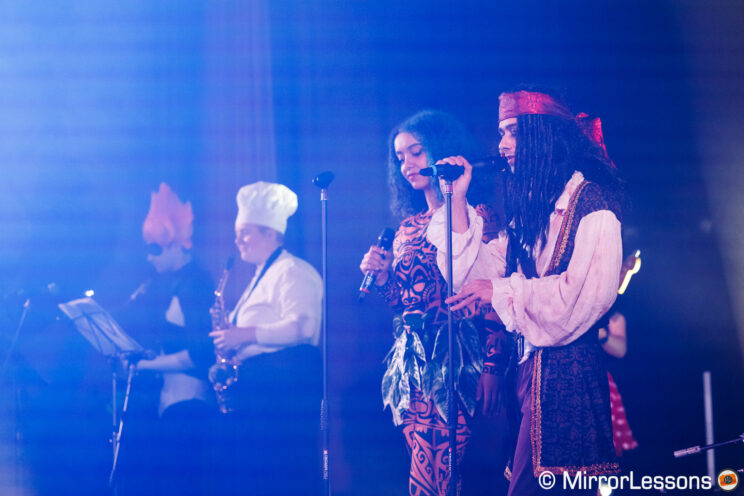
Canon EOS R8, ¹⁄₂₅₀ sec, ƒ / 2.8, ISO 6400
RF85mm F2 MACRO IS STM
In many cases, the R8 should be usable without significant challenges. However, it’s also true that in moments when neither the EFCS nor the electronic shutter perform optimally, R7 users have the advantage of being able to fall back on the standard mechanical shutter, unlike R8 users.
5. Continuous Shooting Speed
With the electronic shutter, the R8 can work up to 40fps, which is quite impressive for a full frame camera. Slower speeds of 20fps and 5fps are also available. On the other hand, the R7 can shoot up to 30fps.
Switch to the mechanical shutter, and the R7 still delivers an impressive 15fps burst, whereas the R8 drops to 6fps when activating the electronic-first curtain shutter.
No doubt, the electronic shutter is where you get the fastest performance on both cameras, but the R8 takes the lead in minimising rolling shutter issues. When panning, there’s less distortion, as you can clearly observe below.
The faster sensor readout on the R8 makes the camera safer to use for action shots, particularly when taking photos of complex subjects like birds in flight. These subjects have more intricate body shapes compared to straightforward objects like lampposts, making any resulting distortion less noticeable and generally not a significant concern.
However, with the R7, the distortion becomes more evident. During my review, I noticed an anomaly in every 3 or 4 photos. The distortion is especially visible in the background, as you can see in this example below: the hide and the tree trunk behind the red kite are clearly distorted.
You can see another example by comparing the two following images: observe how the background wobbles when you switch back and forth between them.
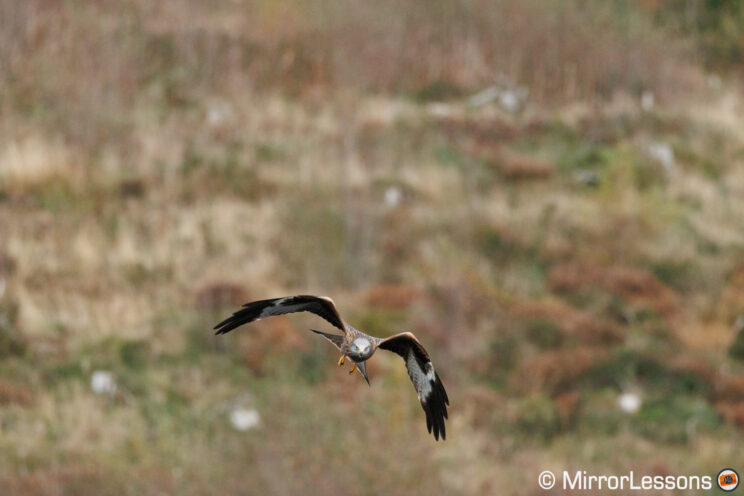
RF100-500mm F4.5-7.1 L IS USM at 500 mm

RF100-500mm F4.5-7.1 L IS USM at 500 mm
Furthermore, there are instances where the R7 exhibits unusual motion blur when image stabilization is engaged, even with mode 2 selected on the lens. I speculate that the minor yet rapid movements of the sensor shift mechanism can exacerbate the rolling shutter issue. In such cases, it’s better to choose a saqfe shutter speed and deactivate the stabilization, a practice that many photographers follow anyway.
Of course, it’s worth noting that you can use the mechanical shutter and work at 15fps with the R7, which is far from disappointing given the resolution of the sensor. However, if you’re interested in the R7’s fastest burst capabilities, you need to be aware of rolling shutter, more so than with the R8.
Moving on to buffer performance, the R7 maintains a pace of 30fps for approximately 2 seconds before slowing down when capturing RAW images, or about 4 seconds with JPGs. The R8 offers the same buffer duration at its 40fps burst rate.
Another noteworthy detail about the R8 is that while shooting at 40fps, it makes lengthy pauses of 6 to 7 seconds before resuming the burst for 1 to 2 seconds, at a reduced speed.
In both cases, you can increase the performance by choosing C.RAW, o the RAW Burst mode. The latter is useful to use in conjunction with the Pre-Release function, where the cameras save 15 frames before the shutter button is fully pressed. It’s a great tool to capture action that is difficult to predict.
Keep in mind that the RAW Burst Mode has certain constraints. Firstly, both cameras store all captured frames in a unique RAW file format that can only be accessed using the Canon software. Alternatively, you can extract the images within the camera itself, but in either scenario, you’re limited to saving one frame at a time. Batch exporting is not an available option.
Secondly, I observed some artifacts in photos taken with the R8 when viewed at 100% magnification. It’s plausible that this issue could be software-related. If that’s indeed the case, hopefully Canon can address it through a firmware update in the future.
Reminder: the links below are affiliate links. If you decided to buy something after clicking the link, we will receive a small commission.
Check the price of the Canon EOS R7 on:
Amazon | Amazon UK | B&H Photo | eBay
Check prices of the Canon R8 on
Amazon | Amazon UK | B&H Photo | eBay
Second-hand Canon cameras on
MPB US | MPB UK
6. Autofocus
The R7 and R8 feature Canon’s Dual Pixel CMOS AF II technology and advanced algorithm to recognise and automatically follow different types of subject, including people, animals and vehicles.
The R8 has a more advanced version, which allows the camera to have a greater understanding of the human body, as well as recognise more species of animals and more types of vehicles.
Subject Det.
R7
R8
Humans
Eyes
Head
Torso
Eyes
Head
Torso
(improved)
Animals
Dogs
Cats
Birds
Dogs
Cats
Birds
Horses
Zebras
Vehicles
Cars
Motorcycles
(helmet priority)
Cars
Motorcycles
(helmet priority)
Trains
Airplanes
Let’s start with my Subject Detection test for humans. Under good light conditions, the R7 achieves an outstanding keeper rate of 90%. Only one image was out of focus, occurring as the subject turned around, along with a few images where tack sharpness on the eyes was slightly compromised.
The R8, on the other hand, elevates the performance with a remarkable 96% success rate. There were no images being out of focus in the sequence; just a few shots where the eyes were slightly soft.
Jumping into 4K 25p video, the performance stay pretty consistent. The R7 has a minor hesitation during the second part of the test as the subject turns around before coming to a stop, but it’s not a big deal to be honest.
Another advantage of the R8 is the low light sensitivity, rated at -6.5EV whereas that of the R7 stops at -5EV (both measured at ISO 100 with a F1.2 lens).
Indeed, the R7 faces more challenges in the low-light scene below. It successfully tracks the subject from start to finish, even when she’s walking through the darkness in the middle of the sequence. However, there is a lack of precision, resulting in a keeper rate of 72%.
On the other hand, the R8 sustains a performance quite similar to my initial test, with an impressive 90% hit rate. Only a few images are slightly soft in the sequence. That said, in movie mode they performance is the same.
Note: I used the RF 70-200mm F2.8 for these two tests, and it’s an impressive lens when it comes to autofocus speed. So, keep in mind that with a different and less expensive lens, like the RF 85mm F2 that I used previously, the keeper rate will decrease, especially in low light.
I’ve had the opportunity to use both cameras during a few concerts, and I can confirm that the R8 holds an advantage. Its subject tracking capabilities and eye autofocus precision are truly remarkable. It’s rare for the R8 to miss focus, despite the lighting design changing constantly and the performers moving a lot on stage. The camera didn’t struggle even when dealing with musicians wearing costumes and masks.
Now, don’t get me wrong — the Canon R7 is more than capable in the same situation. However, subject tracking can be more unpredictable at times, especially when performers are moving a lot and they aren’t always facing the camera head-on. So there might be a few moments where you’ll prefer to work with a smaller AF area, and disable subject tracking.
Concerning animal detection, both cameras perform really well. They are fast and reliable. The bird is detected right away, even when at a distance (meaning small in the frame). Focus is very accurate also when the bird is surrounded by distracting elements (branches, leaves) or when they are in a less favourable position for the camera.
If you manage to work closer to your subject, the R7 and R8 will switch to the head or eye as soon as possible, increasing your chances to get tack sharpness where it matters the most. They will revert to the body or head if the eyes are not visible.
Finally, we have my birds in flight test, and this is where the R8 truly shines. Its autofocus score is impressive, and matches that of the more expensive R6 Mark II, and it’s only a single point away from the flagship R3.
R3
94%
100%
R6 II
93%
99%
R8
93%
99%
R6
93%
97%
R7
80%
93%
The performance is very quick, tracking is always precise and consistent, even when the subject is against a busy background, and the camera almost never hesitates or gets confused.
The R7, however, struggles more in maintaining focus throughout the sequence, more often than anticipated. The autofocus can lock onto the target very quickly, yet it can just as quickly lose focus when the bird is against a busy background, shifting focus to the surrounding trees or field.
Other times, the R7 struggled to readjust focus if it began the sequence out of focus. This occurred frequently enough that I often had to abort the sequence and start again.
All this behaviour also lead to an inconsistent keeper rate, unlike other Canon cameras I’ve tested. Replicating the same keeper rate with every attempt is difficult. The best I achieved was 80%, but more frequently, the R7 averages around 72-75%, despite using the same lens, same settings, and working at the same location in similar conditions.
For this video review, I tested the R7 once more, experimenting with more setting combinations, but unfortunately, the performance remains unchanged.
Reminder: the links below are affiliate links. If you decided to buy something after clicking the link, we will receive a small commission.
Check the price of the Canon EOS R7 on:
Amazon | Amazon UK | B&H Photo | eBay
Check prices of the Canon R8 on
Amazon | Amazon UK | B&H Photo | eBay
Second-hand Canon cameras on
MPB US | MPB UK
7. Design
Despite housing a bigger sensor, the R8 is smaller and lighter than the R7. Both cameras offer a decent level of weather sealing, although it may not be as advanced as more premium Canon models such as the R6 series.
- R7: 132.0 x 90.4 x 91.7mm, 612g
- R8: 132.5 x 86.1 x 70mm, 461g
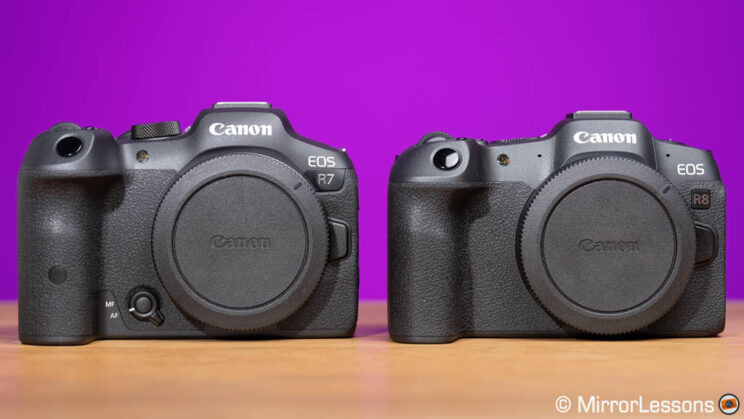
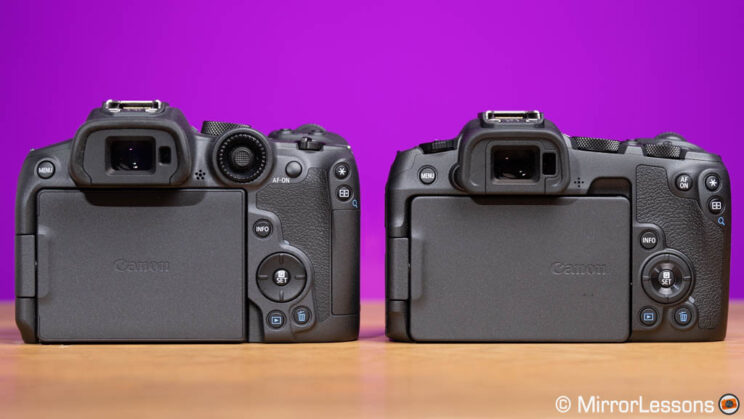
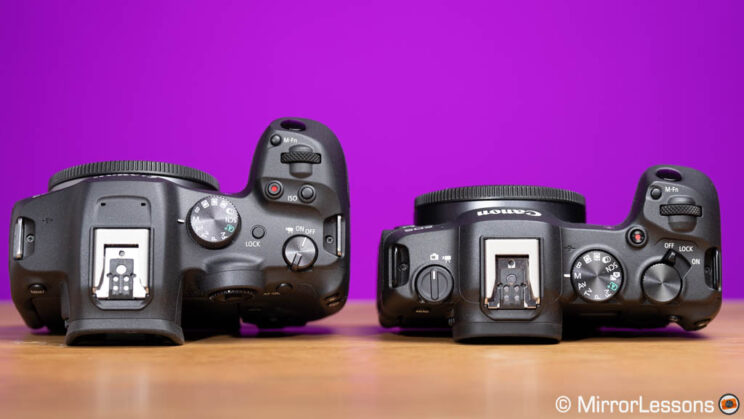
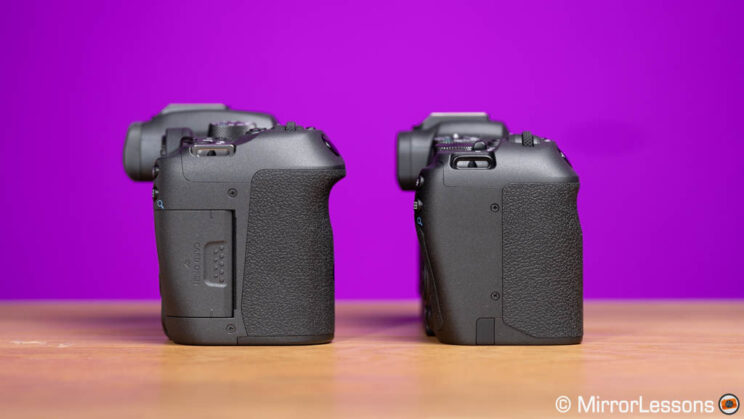
The R7 has a taller grip, which makes it easy to rest all your fingers comfortably. The R8 offers a decent grip, and to be fair I found it easy enough to handle the camera, even with the 100-500mm lens.
The two cameras also differ in terms of a few controls: for example, the R7 has one lever (top right) to turn the camera on, and switch to video mode. The R8 has separate photo/video lever on the left, and an on/off switch on the right that also comprises the lock function.
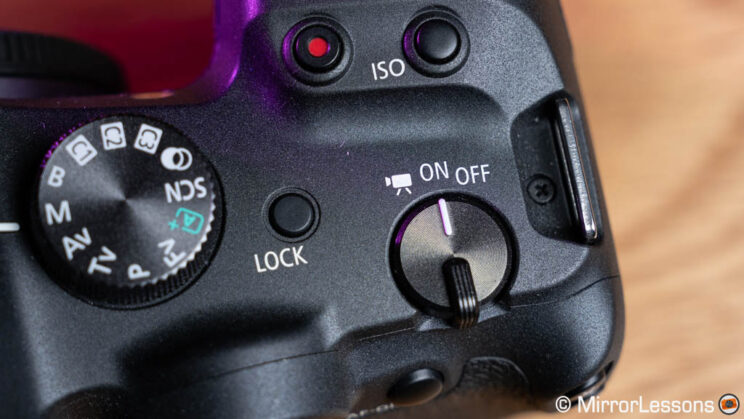
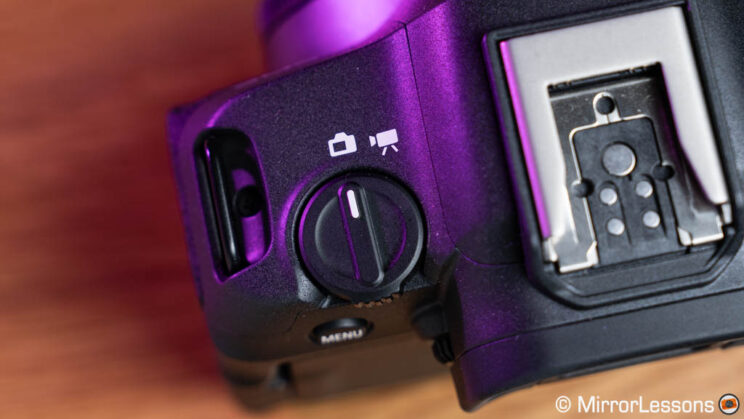
The R7 sports an AF/MF lever located at the front of the camera, with a function button at the centre. It is a clever and very useful addition.
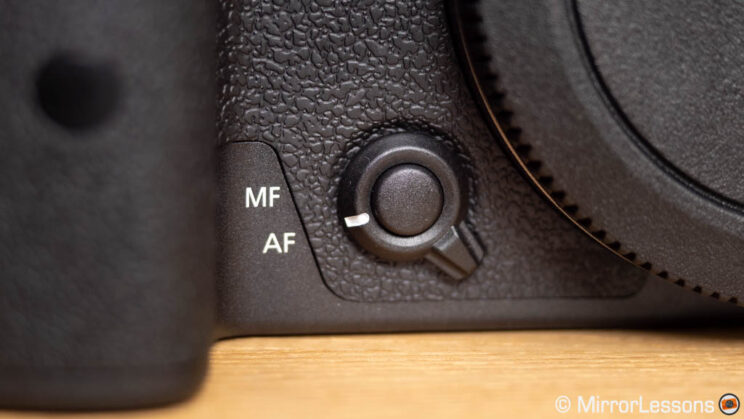
The location of the rear dial differs as well: on the R7, it is larger and positioned on the back panel rather than on top of the camera.
This curious solution adopted by Canon sees the AF joystick placed inside that rear dial. At first, I wasn’t particularly fond of this solution because I often found my finger touching the dial or joystick by accident. However, after owning the camera for several months now, I’ve got used to it to some extent. While there are still occasional moments where it catches me off guard, it doesn’t bother me as much as when I first started using the camera.

Unlike the R7, the R8 doesn’t incorporate a joystick for the autofocus point. Instead, you have the option to either configure the 4-way pad at the rear to directly move the autofocus area, or you can use the touch screen. Furthermore, the LCD allows you to adjust the AF point while composing through the viewfinder — an option that’s also available on the R7 by the way.
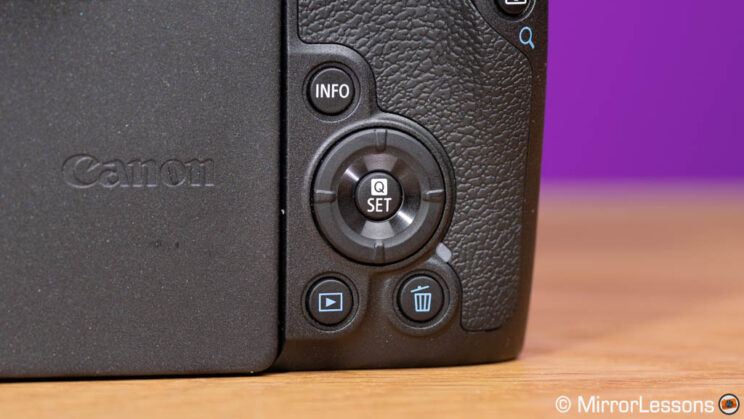
Both the R7 and R8 share the same viewfinder, which is not the standout feature of either model: 0.39-in OLED panel, 2.36M dots of resolution, 22mm eyepoint and 0.72x magnification on the R7 (0.70x on the R8).
They are small and the magnification is a bit limited. For people who wear glasses like me, seeing the entire frame, particularly the corners, can be challenging. However, a positive aspect is that they offer a fast refresh rate of 120Hz.
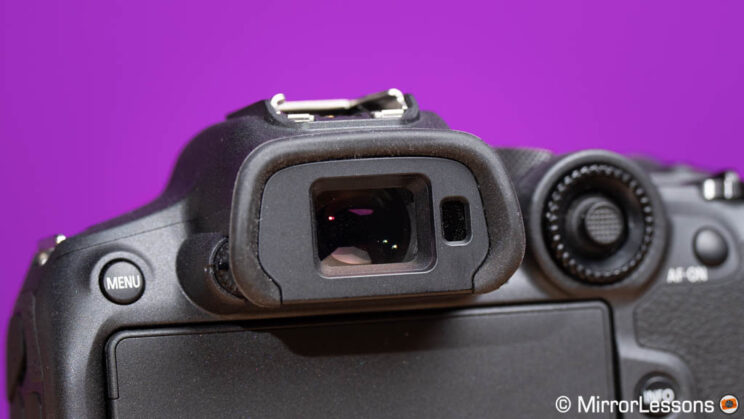
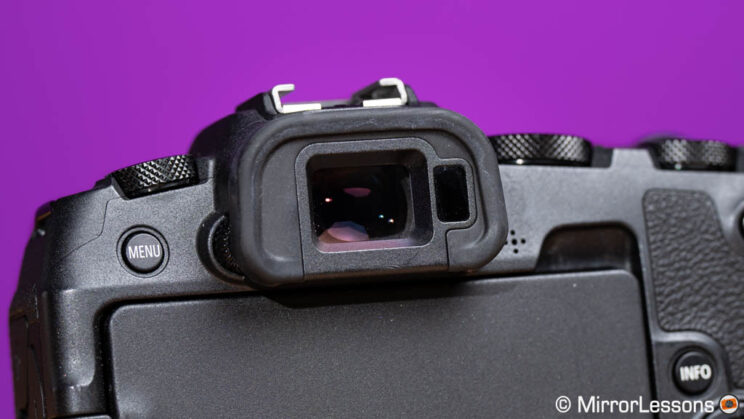
As for the rear LCD screen, it remains identical and is flawless really: high resolution of 1.62M dots, responsive touch capabilities, and the added convenience of a multi-angle mechanism.
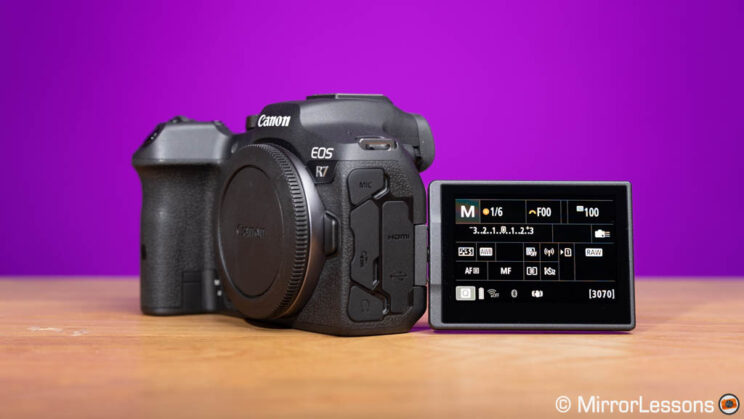
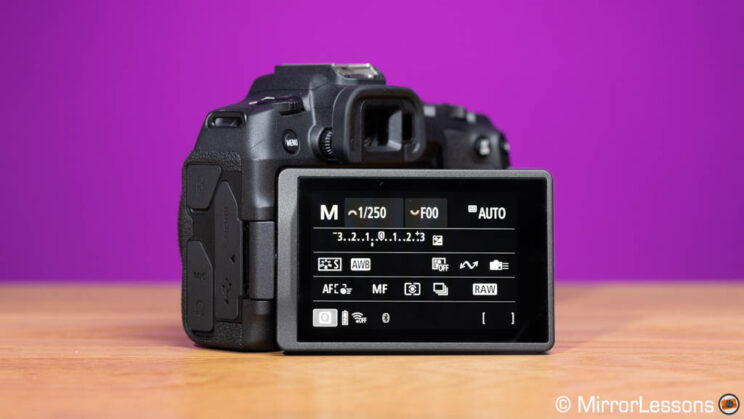
The APS-C camera comes with 12 customisable buttons, while the R8 offers 10. It’s worth noting that if you choose to use the 4-way controller at the rear to adjust the AF point on the R8, you will loose four of these function buttons.
The menu system remains largely consistent across both cameras. Furthermore, the My Menu section and the option to edit the Q menu provide additional flexibility for customisation.
Moving on to the physical connectors, they are the same. With either camera, you get:
- a remote input
- a microphone input
- a headphone output
- a Micro HDMI output
- and a USB Type C port (which works at 10Gbps)

Both cameras are equipped with Canon’s multi-function shoe, which offers multiple options, including the ability to record digital audio using compatible accessories.
8. Battery Life
The R7 has a larger battery, the LP-E6N, that consequentially promises better performance against the smaller LP-E17 included in the box with the R8.
The R7 has an official rating of 500 photos per charge (when using the EVF), or 770 photos when working with the rear monitor.
The R8 is rated at 220 frames with the EVF, and 370 pictures with the LCD.
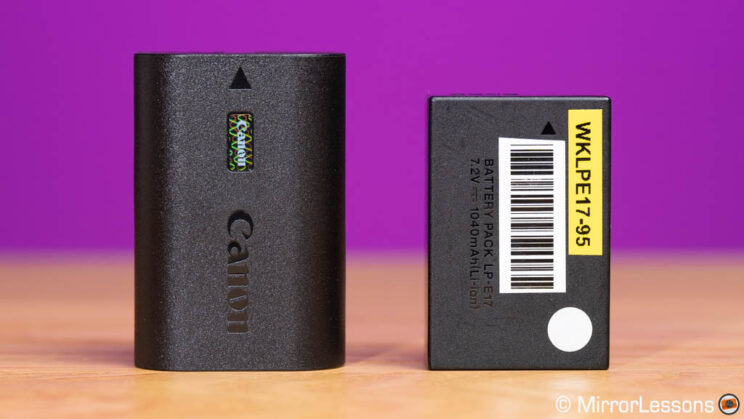
In real world use, the battery performance of the R7 is very impressive. Even after capturing over 2,700 images of birds in flight, a substantial 78% of battery life remained.
In contrast, the R8 managed approximately 1,000 photos of birds in flight, along with a few recorded movie files, before the battery life dropped to 25%.
In terms of movie capabilities, the R7 recorded 2 hours and 20 minutes of 4K 25p video at the maximum quality before the battery died. In comparison, the full frame camera only managed a short duration of 34 minutes in the same conditions.
Neither camera can benefit from an optional battery grip, but you can use the USB C port to charge the battery, or power the cameras while in operation (not that the battery won’t charge with the latter).
9. SD Cards
The R7 has two slots that accept UHS-II cards, and they have a dedicated compartment on the side of the camera, which is easier to access. Two cards mean you can double the capacity, back up one card to the other, or separate JPG and RAW files.
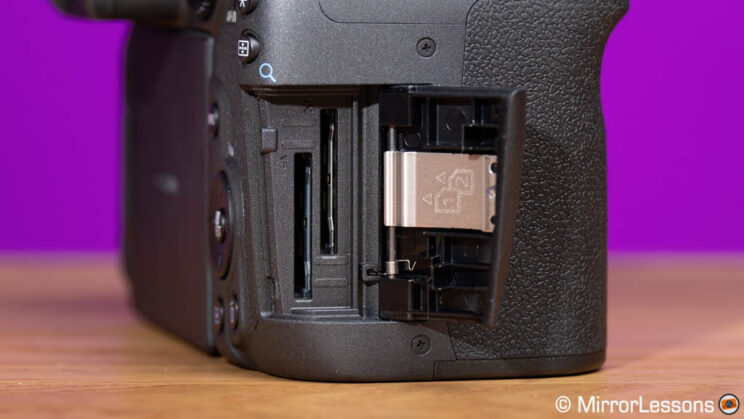
The R8 has one slot only (UHS-II), which is located at the bottom in the battery compartment.
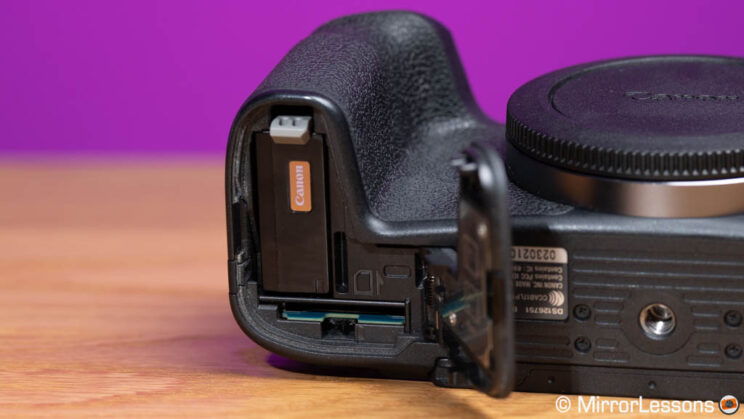
10. Price and Lenses
Depending on where you live, the price of these two cameras is pretty close, especially if we look at the US dollar.
The R7 is being sold at $1400, £1450 or €1500 for the body only.
The R8 has a similar price in the U.S. ($1500) but is more expensive in Europe (£1700 / €1800), body only once again.
Please note that the prices provided above are accurate as of August 2023.
For each camera, you can add roughly $200 or $300 extra respectively for the kit lens (RF-S 18-45mm F4.5-6.3 IS STM for the R7, RF 24-50mm F4.5-6.3 IS for the R8).
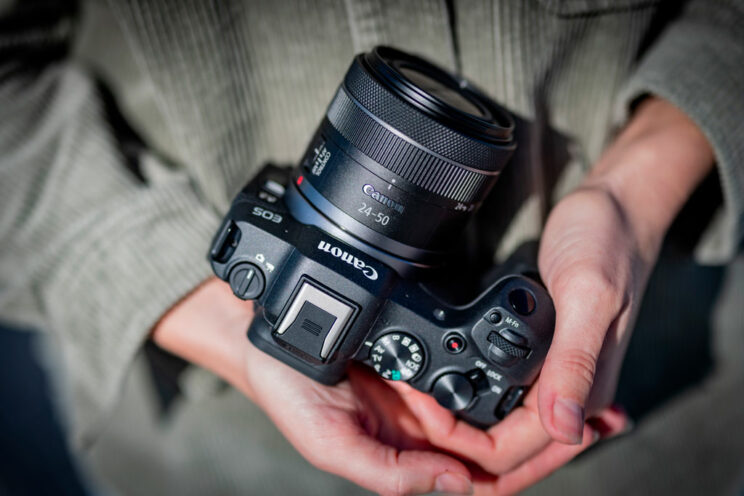
Canon has so far produced three native APS-C lenses for the EOS R mount: 18-45mm, 18-150mm and the most recent 55-210mm. All of them have small and non-constant apertures. If you want anything else, either more telephoto reach, more wide-angle options or a faster aperture, you need to look at the full frame catalogue. Fortunately, there is a good range of fast primes available at a competitive price, as well as affordable super telephoto lenses. Anything beyond that will take you into L lens territory, and the price goes up depending on your needs.
All this to say that at the time of writing this article, Canon has developed more full frame lenses than APS-C lenses, which is fair given the first APS-C camera was unveiled not long ago. It will take more time to find a better balance between the two formats.
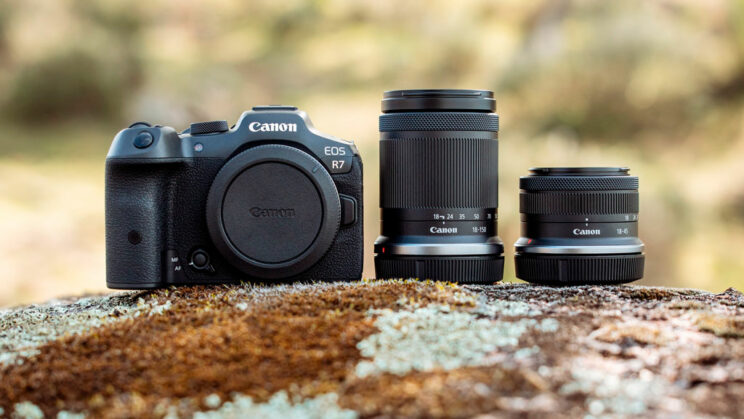
Another limitation is the lack of third-party autofocus lenses directly compatible with the RF mount. It’s still unclear if and when Canon will license its mount to third parties, the latest interview released at the time of finishing this video is quite vague, but then some rumours suggest that the first lenses are coming soon, so it’s still a bit unclear and confusing to be honest. What’s very clear however, is that the EOS R system still has a significant distance to cover before reaching the range of options available for other systems such as Sony.
So if you want more choice, you need to look at DSLR lenses (there is a lot for Canon’s EF mount, and the EOS R to EF adapter works really well), or manual focus lenses from Samyang and the like.
Reminder: the links below are affiliate links. If you decided to buy something after clicking the link, we will receive a small commission.
Check the price of the Canon EOS R7 on:
Amazon | Amazon UK | B&H Photo | eBay
Check prices of the Canon R8 on
Amazon | Amazon UK | B&H Photo | eBay
Second-hand Canon cameras on
MPB US | MPB UK
Review Video
Other comparisons you might be interested in:
Conclusion
I haven’t covered extra features in detail, but I can briefly mention that both cameras offer a range of useful functions. For instance, they both include focus bracketing and focus stacking in-camera, and they work quite well. They can also serve as cameras for streaming with just a USB cable, eliminating the need for additional software. Additionally, they come with Bluetooth, WiFi and a Time-lapse function.
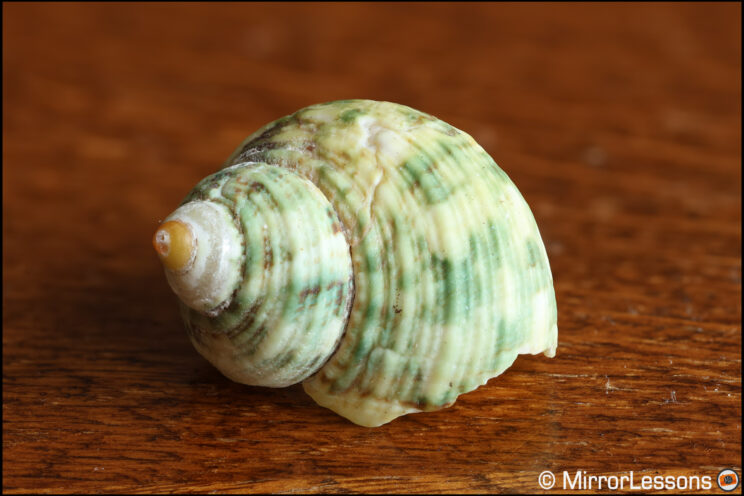
RF85mm F2 MACRO IS STM
In-Camera Focus Stacking (Focus increment: 1)
And that brings us to the conclusion. So, the price is relatively similar, depending on where you live, but otherwise these two cameras are very different. The R7 has superior ergonomics, a larger grip, a bigger battery, more physical controls, and supports dual memory cards. It has a smaller APS-C sensor, but offers a lot of resolution, a highly effective five-axis image stabilisation system, and very good video quality in 4K up to 30p. It is one of the most competitive APS-C mirrorless cameras on the market, especially when you consider its price.
On the other hand, the R8 may lack a bit in terms of design and ergonomics, but its full-frame sensor delivers the expected advantage in image quality, especially with dynamic range and high ISO performance. It also provides superior quality in 4K at 50 and 60p.
Another substantial distinction lies in the autofocus capabilities: while the Canon R7 delivers commendable results across various shooting conditions, the R8 excels across the board. Whether it’s portraits, events, wildlife, or fast-paced action like birds in flight, the R8 delivers exceptional performance, at a level akin to the flagship Canon R3, all at a fraction of the price.
Another aspect worth highlighting is the rolling shutter issue with the R7. While this might not be a concern for everyone, and that’s fair, it can limit those who are particularly enthusiastic about making the most of the camera’s fastest drive speed. In contrast, the R8 lets you utilise the faster burst of 40fps with more peace of mind.
Reminder: the links below are affiliate links. If you decided to buy something after clicking the link, we will receive a small commission.
Check the price of the Canon EOS R7 on:
Amazon | Amazon UK | B&H Photo | eBay
Check prices of the Canon R8 on
Amazon | Amazon UK | B&H Photo | eBay

